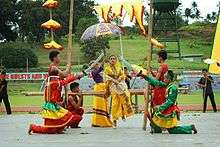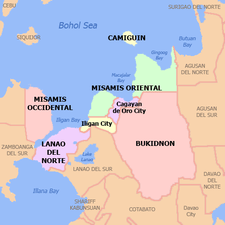Lanao del Norte
| Lanao del Norte | |||
|---|---|---|---|
| Province | |||
| Province of Lanao del Norte | |||
 The Provincial Capitol grounds in the capital town of Tubod | |||
| |||
 Location in the Philippines | |||
| Coordinates: 8°02′N 124°00′E / 8.03°N 124°ECoordinates: 8°02′N 124°00′E / 8.03°N 124°E | |||
| Country | Philippines | ||
| Region | Northern Mindanao (Region X) | ||
| Founded | May 22, 1959 | ||
| Capital | Tubod | ||
| Government | |||
| • Governor | Imelda "Angging" Q. Dimaporo (LP) | ||
| • Vice Governor | Cristy Atay (LP) | ||
| Area[1] | |||
| • Total | 3,346.57 km2 (1,292.12 sq mi) | ||
| Area rank | 40th out of 81 | ||
| (excluding Iligan City) | |||
| Highest elevation (Mount Inayawan) | 1,535 m (5,036 ft) | ||
| Population (2015 census)[2] | |||
| • Total | 676,395 | ||
| • Rank | 43rd out of 81 | ||
| • Density | 200/km2 (520/sq mi) | ||
| • Density rank | 46th out of 81 | ||
| (excluding Iligan City) | |||
| Divisions | |||
| • Independent cities |
1
| ||
| • Component cities | 0 | ||
| • Municipalities | |||
| • Barangays |
| ||
| • Districts | 1st and 2nd districts of Lanao del Norte | ||
| Time zone | UTC+8 (PHT) | ||
| ZIP codes | 9201–9222 | ||
| IDD : area code | +63 (0)63 | ||
| ISO 3166 code | PH | ||
| Spoken languages | |||
| Income classification | 2nd class | ||
| Website |
www | ||
Lanao del Norte (Maranao: Ranao Pangotaraan, Cebuano: Amihanang Lanao) officially the Province of Lanao del Norte, is a province in the Philippines located in the Northern Mindanao region. Its capital is Tubod.
The province borders Lanao del Sur to the southeast, Zamboanga del Sur to the west, Illana Bay to the southwest, Iligan Bay to the north, Iligan City to the northeast, and is separated from Misamis Occidental by Panguil Bay to the northwest. According to the 2015 census, the province has a total population of 676,395 people.[2]
Situated within Lanao del Norte is the highly urbanized city of Iligan, which is governed independently from the province.
History
The province of Lanao existed from 1914 until 1959. Republic Act No. 2228 divided Lanao into two (2) provinces creating Lanao del Norte and Lanao del Sur.[3] The new province was inaugurated on July 4, 1959 making Iligan City as the capital.
The province then consisted of the following municipalities:
- Baloi
- Kauswagan
- Bacolod
- Maigo
- Kolambugan
- Tubod
- Baroy
- Lala
- Kapatagan
- Karomatan
and the following municipal districts (converted into regular municipalities in the future):
- Matungao
- Pantao-Ragat
- Munai
- Tangcal
- Nunungan
In 1977, President Ferdinand E. Marcos signed Resolution No. 805, series of 1977 of the Sangguniang Panlalawigan (Parliamentary Bill No. 586) sponsored by Assemblyman Abdullah D. Dimaporo, into Presidential Decree 181 transferring the province's capital from Iligan City to the municipality of Tubod.
In October 1984, inaugural ceremonies were held to celebrate the occasion of the transfer of the Provincial Capitol from Poblacion, Tubod to the Don Mariano Marcos Government Center (now Governor Arsenio A. Quibranza Provincial Government Center) at Pigcarangan, in Tubod.
Despite the outbreak of the conflict of the MILF led by Abdullah Commander Bravo Goldiano Macapaar bin Sabbar and the Philippine Army in Kauswagan on March 2000, through the provincial government's effort, peace and order was restored in the province.
Geography
Lanao del Norte is a rugged province that ranges from the coastal shorelines in the north to the high plateaus and mountains in the south. It has also diverse flora and fauna.
Lanao del Norte covers a total area of 3,346.57 square kilometres (1,292.12 sq mi)[4] occupying the southwestern section of the Northern Mindanao region in Mindanao. When Iligan City is included for geographical purposes, the province's land area is 4,159.94 square kilometres (1,606.16 sq mi).[4] The province is bordered by Lanao del Sur to the southeast, Zamboanga del Sur to the west, Illana Bay to the southwest, Iligan Bay to the north, Iligan City to the northeast, and the Panguil Bay to the northwest.
Administrative divisions
Lanao del Norte comprises 22 municipalities. The city of Iligan administers itself independently as a highly urbanized city.
- † Capital municipality
- Municipality
- ‡ Highly urbanized city (geographically within but independent from the province)
| ||||||||||||||||||||||||||||||||||||||||||||||||||||||||||||||||||||||||||||||||||||||||||||||||||||||||||||||||||||||||||||||||||||||||||||||||||||||||||||||||||||||||||||||||||||||||||||||||||||||||||||||||||||||||||||||||||||||||||||||||||||||||||||||||||||||||||||||||||||||||||||||||||||||||||||||||||||||||||||||||||||||||||||||||||||||||
Demographics

| Population census of Lanao del Norte | ||
|---|---|---|
| Year | Pop. | ±% p.a. |
| 1990 | 387,524 | — |
| 1995 | 440,783 | +2.44% |
| 2000 | 473,062 | +1.53% |
| 2007 | 538,283 | +1.80% |
| 2010 | 607,917 | +4.53% |
| 2015 | 676,395 | +2.05% |
| (excluding Iligan City) Source: Philippine Statistics Authority[2][5][5] | ||
The population of Lanao del Norte in the 2015 census was 676,395 people,[2] with a density of 200 inhabitants per square kilometre or 520 inhabitants per square mile. When Iligan City is included for geographical purposes, the province's population is 1,019,013 people, with a density of 245 inhabitants per square kilometre (630/sq mi).
The people in Lanao del Norte are a mixture of Maranaos and Cebuanos, with some Chabacanos, Tausugs, Yakan, and Sama-Bajau. Historically, immigrants who came from the Christian provinces of Mindanao, Visayas and Luzon tended to settle in the Northern part of Lanao while the Maranaos inhabited the south. There are also a minority of Higaunons settling in the hinterlands of Iligan City.
The Maranao is an ethnic group of Malay descent. They settled in the area long before the advent of the Spaniards in the Philippines. They possess their own culture and civilization which makes them quite unique. Their language, customs, traditions, religion, social system, costumes, music, and other features are factors that make Lanao peculiar and distinct from other Philippine provinces.
The main languages are Maranao and Cebuano. Other language spoken is Chabacano, spoken by both Christians and Muslims.
Religion
According to the Philippine Statistics Authority (PSA) report on 2015, 44.19% of the population of the Lanao Del Norte are adherent of Islam [8](predinantly Sunnites). Other sizeable Islamic sects are Ahmadiya, Sufism, Shia etc.
Other sects are Christianity, Buddhism and other beliefs.
Economy
The economy in Lanao del Norte is predominantly based on agriculture and fishing. Factories are mostly based in Iligan City. Lanao del Norte is the home of Agus Power plants 4-7 that stretch from Balo-i to Iligan City. It serves at about 70% of power supply in Mindanao. Tourism is also a growing economy in the province.
Politics and government
Salvador T. Lluch was the first Governor of Lanao del Norte. Second was Mohammad Ali Dimaporo, from January 1960 to September 1965 when Governor Dimaporo ran and won the congressional seat of the province. By operation of the law of succession, Vice Governor Arsenio A. Quibranza became the third Provincial Chief Executive of the province. By the mandate of the inhabitants, Governor Quibranza was elected Governor in 1967 and almost unanimously re-elected in 1971 and again in 1980.
By virtue of the power and impact of the People Power Revolution at EDSA, Manila on February 25, 1986, local government all over the Philippines changed the political atmosphere overnight. Lanao del Norte became one among the many provinces affected by the sudden changes brought by the "Snap Election" on February 1986. Local heads of offices and employees particularly those holding political positions were destabilized but with the installation of President Corazon Aquino as president, OIC Atty. Francisco L. Abalos became the appointed governor of the province on March 3, 1986. On February 2, 1988, Atty. Abalos was elected as governor of the province.
In the Synchronized National Election of May 11, 1992, Congressman Abdullah D. Dimaporo, a legislator and economist, was elected Provincial Governor. The Provincial government embarked on a comprehensive planning and set the groundwork for the development of the province.
In the 1998 national and local elections, Imelda Quibranza-Dimaporo, wife of Governor Abdullah. D. Dimaporo was elected as Provincial Governor until 2007.
The eldest son of former Governor and now 2nd district representative Abdullah D. Dimaporo and incumbent Gov. Imelda Q. Dimaporo, Mohammad Khalid Q. Dimaporo enter the politics in the province since 2007 - 2016.
See also
References
- ↑ "List of Provinces". PSGC Interactive. Makati City, Philippines: National Statistical Coordination Board. Archived from the original on 21 January 2013. Retrieved 26 June 2014.
- 1 2 3 4 5 Census of Population (2015). "Region X (Northern Mindanao)". Total Population by Province, City, Municipality and Barangay. PSA. Retrieved 20 June 2016.
- ↑ "Republic Act No. 2228 - An Act to Create the Provinces of Lanao del Norte and Lanao del Sur". Chan Robles Virtual Law Library. Retrieved 24 December 2015.
- 1 2 3 4 "Province: Lanao del Norte". PSGC Interactive. Quezon City, Philippines: Philippine Statistics Authority. Retrieved 8 January 2016.
- 1 2 3 Census of Population and Housing (2010). "Region X (Northern Mindanao)". Total Population by Province, City, Municipality and Barangay. NSO. Retrieved 29 June 2016.
- ↑ Table 11. Household Population by Ethnicity and Sex: 2010 (Lanao del Norte)
- ↑ Table 11. Household Population by Ethnicity and Sex: 2010 (Iligan City)
- ↑ Philippine Statistics Authority (July 26, 2017). "Muslim Population in Mindanao (based on POPCEN 2015". Retrieved Aug 31, 2018.
External links


- Philippine Standard Geographic Code




